Math Lives Everywhere
January 3, 2024 - 7 minutes readIt’s been a long time since I taught Grade 3 at Gleneagles Elementary School (now Gleneagles Ch’axáý) at the beginning of my career. But I vividly remember regularly administering timed multiplication drills to my class. Looking back, that ‘race against the clock’ approach where students worked through rows upon rows of questions must have been daunting and rather discouraging especially for learners who lacked confidence in their abilities. And I’m pretty sure I wasn’t fostering a love of math learning!
Hollyburn Elementary School is in the second year of its school goal, “To improve number sense and increase student ownership of math learning from K-7”. Our team is focusing on building math skills and developing students’ confidence in math, all the while making math learning fun and meaningful. We hope to see a shift away from statements like, “I can’t do Math” and “I don’t have a Math brain” to statements indicative of a growth mindset.
How are we developing confident math learners?
There is still a place for math drills in schools today, but it looks quite different. Teachers are leveraging technology and using individualized drill systems that develop fluency in numeracy while fostering a love for math. I was in a Grade 3 classroom recently where the students were using devices to access IXL, a personalized learning math tool. Understanding was the focus, not the speed of completion. There was so much joy in that Grade 3 classroom! Students eagerly worked through the visually stimulating, yet challenging questions designed to develop computational fluency. Technology has undoubtedly changed the landscape for learning in general and it certainly has in the area of math.
When I wandered in a Grade 6/7 classroom, I sensed lots of positivity and fun as the teacher used individual whiteboards for a quick review of prior math learning. Students recorded answers and their thinking on a whiteboard and held it up for the teacher to scan and check for understanding. It was impressive to see all students on task, listening, engaged, and smiling!
As we enroll students from many different backgrounds, teachers use stories related to land, culture, and history to introduce and explore math concepts. This helps foster students’ sense of belonging as they feel ‘seen’. Last November, to highlight the Indian festival ‘Diwali’, students in our younger grades explored patterns in the world by creating a Rangoli with materials at home or in nature.
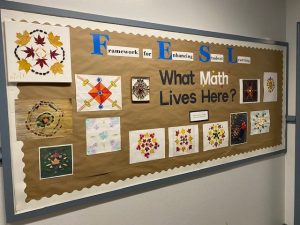
Teachers are mindful of the importance of Indigenous ways of knowing and provide collaborative, holistic, and experiential learning experiences. We are fortunate that our school is situated near forests and beaches and teachers capitalize on our location by regularly taking students outdoors for learning opportunities. One of our primary classes went to a nearby park with the task, ‘what lives in the forest’. They measured pinecones, weighed pieces of bark, found patterns in trees, and symmetry in leaves. Our Kindergarten students recently investigated ‘what math lives at the beach’.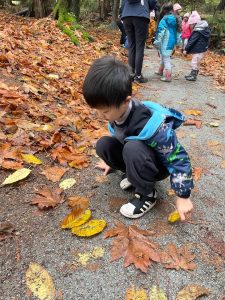
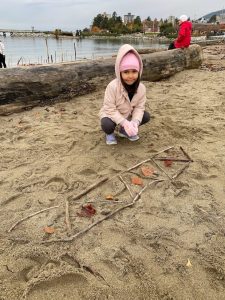
Students often work collaboratively on math problems and activities which helps develop their confidence. They learn from one another and may feel less discouraged than when working independently. Group activities help students learn the important skill of working together as a community of learners. Below, primary students play the Stick Game, a game which traditionally used animal bones to keep score.
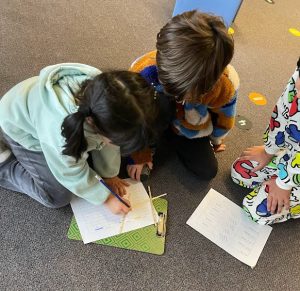
When I entered the Grade 2/3 classroom pictured below, I was greeted with screeches of laughter. Students were playing “Number Battle”, a game using dice to develop an understanding of place value. What great learning, and it looked way more fun than completing a worksheet!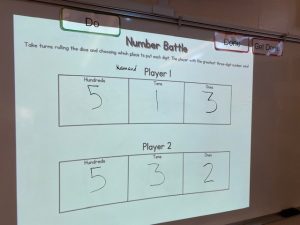
Once a term we invite parents into classrooms to learn alongside their children. To highlight our school goal, these ‘Family Fridays’ focus on math activities and games. This helps parents be actively involved and engaged in their child’s numeracy development. 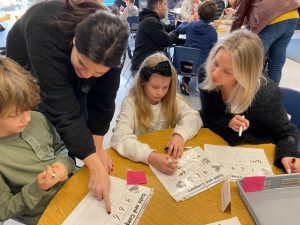 Math helps us in our daily lives, yet it also enables many career paths to be accessible. Parents have been invited to speak to classes about how math is used in their jobs. We look forward to having a parent speak to an intermediate class this month about software engineering, coding, and the importance of lifelong learning. By showing our students how math is used in many careers and in life, we hope they will understand the relevance of math learning.
Math helps us in our daily lives, yet it also enables many career paths to be accessible. Parents have been invited to speak to classes about how math is used in their jobs. We look forward to having a parent speak to an intermediate class this month about software engineering, coding, and the importance of lifelong learning. By showing our students how math is used in many careers and in life, we hope they will understand the relevance of math learning.
According to The World Economic Forum, four of the top ten skills for 2025 include analytical thinking and innovation, complex problem-solving, critical thinking and analysis, and technology design and programming. Having a strong grasp of math is fundamental to being confident and competent in all of these areas. At the elementary level, it is important to set our students up for success in the future. Arming them with knowledge and making math fun in the early stages will help students develop confidence and have a positive attitude towards math, one that we hope will be sustained throughout their schooling and life.
Math lives everywhere in our world, and it certainly lives at Hollyburn Elementary School. We will continue working together to infuse joy into the learning and support each child on their math learning journey.
Recent Comments